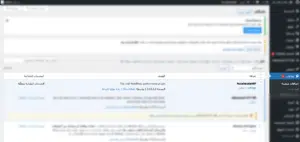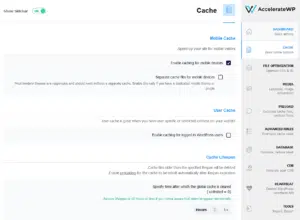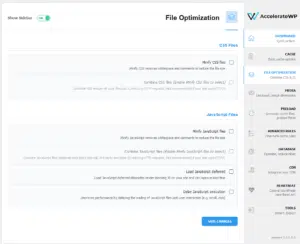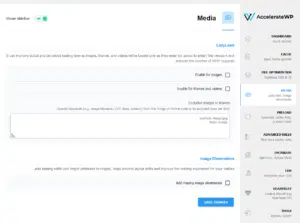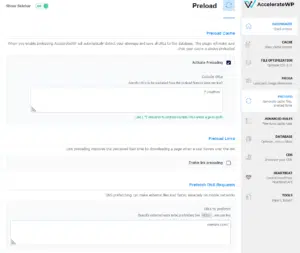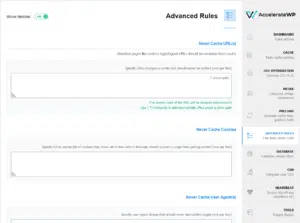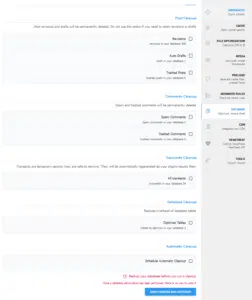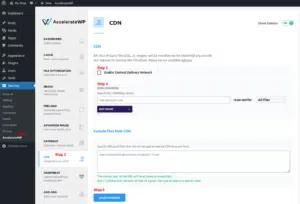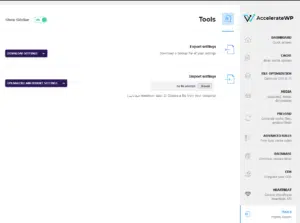Explanation of AccelerateWP settings
As we explained previously and defined
AccelerateWP is a complex solution to help clients increase the performance of their WordPress site. With AccelerateWP, you can manage optimization features, such as object caching, CSS and JavaScript pre-handling, and website preloading.
It examines the capabilities of AccelerateWP, the all-in-one performance optimization feature currently being offered in CloudLinux.
Hayat Host has been keen to activate this service to our customers.
Explanation of its settings #
Explanation of AccelerateWP settings
AccelerateWP feature additional options
Mobile caching #
Mobile caching Use only if your website is optimized for use on smartphones and mobile phones.
Separate cache files for mobile devices. In this case, content for mobile devices will be cached in a different cache file as it is for desktop/tablets.
This option is necessary if you only have some functions for mobile devices, and not for desktop computers / tablets.
The following diagram helps you understand if you need mobile caching.
User Cache #
User cache This option is recommended when your website contains content that is unique to each logged in user. If the user is not logged in, a global cache of the site will be used, otherwise the content of each logged in user will be stored separately.
File Optimization #
File optimization consists of minification and file merging.
Minification is the process of minimizing code in web pages and script files. Webmasters view minification as a primary way to reduce website load times through the bandwidth they use.
Reduce also reduces JS, CSS, and HTML files. The goal is to remove extra comments and spaces. It grinds down variables which reduce code and ultimately reduce file size.
After minification, the file still works as it should. The difference is a decrease in bandwidth due to network requests.
By combining CSS and JS files, HTTP/1 does not allow multiple requests from the same TCP connection between a host server and a web browser.
Placing CSS and JS files in their own collections makes browser download requests safer and more efficient. The old way means multiple connections consuming bandwidth.
Combining files (CSS & JS) is not necessary for HTTP/2 (see https://webspeedtools.com/should-i-combine-css-js/)
HTTP/2 introduced multiplexing. Now, the browser can send an unlimited number of requests to the server, and then download all the files at once using just one TCP connection.
Thus, HTTP/2 takes care of the multiple TCP connections and waiting time before each download. In a sense, merging CSS and JS files may be superfluous.
To check the HTTP version used for requests on your site, you can use
https://tools.keycdn.com/http2-test
CSS Files #
Minify CSS
CSS minification reduces file sizes by removing white space and inline comments.
Combine CSS
Merging CSS reduces HTTP requests by consolidating all your files into one. Incorporating CSS is not recommended if your site uses HTTP/2.
Excluded CSS Files
To specify which CSS files should not be minified, list the URLs attached to the CSS files that should be excluded from minification and concatenation (one per line).
To prevent this, use (.*). CSS wildcards to exclude all files in a specific location.
Third Party: When excluding external CSS files, use the domain or the full URL path.
JavaScript Files #
Minify javascript files
Minify JavaScript removes whitespace and comments to reduce file size.
Combine JavaScripts files
This option will only be active if you choose to minify javascript files. Not recommended for HTTP2.
Load JavaScript deferred
One of the main reasons for slow web pages is something called blocking software:
Loading a javascript called a blocking script that prevents the web page from loading.
Using the defer attribute alerts the browser not to wait for the script. Things will continue as normal for the HTML and DOM builds. Quietly, the script rests in the background, and then runs once the DOM is created.
Therefore, the deferred load JavaScript option adds the defer attribute to each script tag.
Delay JavaScript Execution
This option helps reduce page load time by delaying the loading of all JavaScript files on the page. This option can only be applied to already cached pages, it is not compatible with the Merge JavaScripts files option.
Media #
LazyLoad
On the page in the following way – if the user opens the page for the first load, only the first images will be displayed (visible to the user), and the other images will be loaded if the user scrolls down. Images added via a CSS file, <style> tag or via Elementor will not be affected by LazyLoad.
The following options allow to work with LazyLoad
- Enable LazyLoad for photos
- Enable LazyLoad for inline frames and videos
- Excluded embedded images or frames
Image Dimensions #
Add the missing image dimensions
Correct image dimensions help the browser to learn about the page structure without delay, because the browser knows how much space the image needs.
Cases in which the image will not be affected by adding missing image dimensions:
- Images that have any attribute with a name containing *height* or *width*
Pictures that are part of the <picture> tag
SVG images
An image of the outer spheres
Preload #
Preload Cache
Usually, a page cache is created when you visit this page for the first time. You can activate the preload page cache. This means that the page cache will be created when the page is created or updated.
If sitemap-based cache preload is activated, a specific sitemap will be used to create the initial cache.
Preload Links
Provides the function of preloading the HTML content of the passed link to speed up page loading after clicking.
Prefetch DNS Requests
If your website uses external resources (such as Google fonts, YouTube video, etc.), AccelerateWP can preload those resources to speed up page loading. To activate preloaded external URLs, provide a list of external URLs.
Preload Fonts
It speeds up the loading of fonts by the browser, and informs the browser at the beginning of the request of the full list of fonts to download
Advanced Rules #
Advanced site caching settings. If you have certain pages that need to be processed individually, you can add a custom rule to them.
Never Cache URL(s)
Provide a list of URLs that cannot be cached.
Never Cache Cookies
Provide a list of cookies that cannot be cached.
Never Cache User Agent(s)
Provide a list of user agent names that cannot be cached.
Always Purge URL(s)
You can specify which URLs will be deleted from the cache when any post or page is updated.
Cache Query String(s)
By default, AccelerateWP does not cache URLs with query strings, but in this option you can specify which GET parameters should be cached.
Database #
Database optimization provides database clearing of expired and unused data.
Post Cleanup
Clear Posts provides revisions, auto-saved drafts, and posts deleted from the trash. Be careful, you will not be able to recover this data after erasing it.
Comments Cleanup
Provides clearing of spam and deleted comments from the trash. Be careful, you will not be able to recover this data after erasing it.
Transients Cleanup
Provides clearing of temporary options for existing plug-ins and old, unused options that are retained after plug-ins are deleted.
Database Cleanup
Provides optimized table in your database server.
Automatic cleanup
It allows you to schedule periodic cleanups of the database.
Heartbeat #
WordPress Heartbeat is a server polling function that provides delivery data from the server to the browser periodically.
Reduce or disable Heartbeat activity
To control server loads, you can activate the Control Heartbeat function and reduce or disable Heartbeat activity. You can manage Heartbeat activity separately for back-end, front-end, and post-modification panes. Be careful, disabling Heartbeat may disable plugins that use this functionality.
One-click AccelerateWP Add-ons #
Varnish
When the server is using Varnish, you need to activate the add-on to perform a varnish cache flush when AccelerateWP clears the site cache.
WebP Compatibility
If your site uses the WebP plugin, you can activate the AccelerateWP WebP Compatibility add-on to achieve browser compatibility with your WebP images.
Explanation of AccelerateWP settings #
CDN #
CDN stands for Content Delivery Network, and it’s the feature that simplifies and speeds up resource loading for your customers.
To get started with a CDN, you need:
- A public website on the Internet with a valid domain name
- Drag the CDN region, for example, https://bunny.net/
To setup a CDN in AccelerateWP, you have to register a CDN zone and get the pull zone configuration.
After setting up the pull area, you will receive an address, for example: domain.b-cdn.net
Go to WP Admin on your WordPress site, open AccelerateWP Settings (Step 1) and select the CDN section (Step 2). Select the option: Enable Content Delivery Network (step 3) and fill in the “CDN CNAME(s)” field with the previously received domain.b-cdn.net address (step 4)
Click the Save Changes button.
To verify that the CDN is working, open the website in incognito mode with the developer tools open in your browser. Go to the Network tab, find the Domain column, and you should see the address specified in the AccelerateWP plugin CDN settings for js / css / image files.
Tools #
To back up settings, there is a function to export settings. To use it, click the Download Settings button. When you need to restore the settings, choose the saved settings file and click the Upload File and Import Settings button
Explanation of AccelerateWP settings
